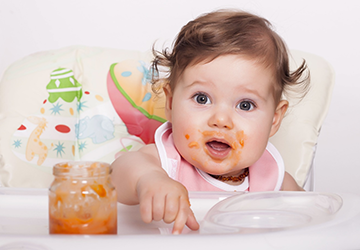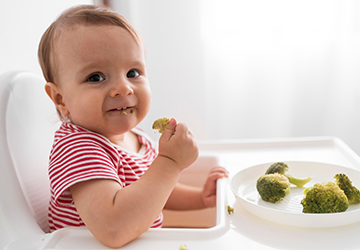If you are trying to get your baby to switch to solid food, this is one of the most significant milestones of parenthood. It can be fascinating yet nerve-wracking to see your child try new tastes and textures, explore their food, and enjoy it, which is fun and exciting. There are so many different flavours that your little one can explore and discover, and this is a step to them becoming independent. As fun and exciting as it sounds, introducing solid food to your baby can scare parents.

If you are thinking of giving solid food to your little angel but don't know where to start, don't worry—we've got you covered. This post will cover mainly the art of introducing solid food to your baby, how to make it safe, and what type of food you should give them. So, let's jump right into the article and look at it.
You might wonder when it is best to introduce solid foods to your baby. Generally speaking, babies between 4 and 6 months are allowed to eat solids. However, you must keep a check on your baby, and only when their digestive tract is developed should you start giving them the food. Babies younger than four months also do not have enzymes that can break the food into simpler components.
It is recommended that babies be introduced to solid foods at six months of age to prevent indigestion. Furthermore, if your baby keeps their head upright or holds themselves with some support, they are prepared to begin eating solid food. Contrary to this, anything like toys and hands shows that you may start feeding your baby solid items.
The next thing you should know as a parent is how to start giving them food, but in a safe and guided manner. You need to make a positive relationship with the food, and if not done correctly, this can make it very hard for the bay to start liking food, and they can have serious health problems. The following are some tips that you can use to make the entire process easier for yourself and even for your little ones.
It would help if you timed it according to what suits your family. Many babies are breastfeeding, especially if yours is one of them, and you can try giving them each solid food regularly while it is breast milk, which they get first. You can start reducing the amount of formula milk and giving them solid food with it.
You can introduce your baby to one meal of solid foods a day, and if you see signs of pleasure in the baby's behaviour, you can increase the number of meals.
Keeping an eye on your baby's mood when eating sold foods is very important. A happy and cheerful baby will be more open to eating and trying new flavours and textures. A happy baby will enjoy food; however, if you have a fussy and sleepy baby, it would be best not to give him solid food.
If you try feeding a fussy and angry baby solid food, he might not find it pleasing and start having a negative relationship with it; this is why it would be best to skip solid meals when your baby is not in the best mood.
Many people feed their babies while putting them on their laps, and let us tell you, this is a recipe for disaster. Putting your baby in your lap and trying to feed them can make them feel trapped, and this might not be the best experience for them. That is why it is suggested that they have a high chair in which they can sit straight and you can also feed them easily.
Letting them be independent and allowing them to eat their food can be a fantastic way to introduce solid foods to your baby. You can give them purees and soft food and let them discover it themselves; this is a great way to make your little ones more independent, help build their motor skills, and promote mental growth.

You must do this carefully. Ensure the food is blended correctly, and no big chunks can be a choking hazard for them. Also, ensure you are sitting or watching them while they are trying to feed themselves.
Knowing when to stop feeding your baby is very important. If your baby turns their head when you are trying to feed them, a clenched mouth is the most prominent sign that they want to stop eating. Force-feeding your little ones can have a negative impact, and they might stop eating the sold food in the future.
When you introduce food to your baby, you must give it as a puree. For babies aged 4 to 6 months, starting them with fruits and vegetable purees can be the first step for solid food.
When making purees, ensure the paste is not very thick, there are no chunks in the meal, and it is finely mashed. This manner of feeding will prevent your baby from choking on the food and make it easy for them to digest it.
We are sure you are also excited for your petite angels to start having solid foods, but this can be a little emotional and overwhelming. Every parent is scared of giving solid food to their baby, but trust us, if you do it securely and guided, your baby will have a lot of fun. Hence, we hope that with the help of this article, you learn how to introduce solid food to your baby safely and help them start exploring the food world.